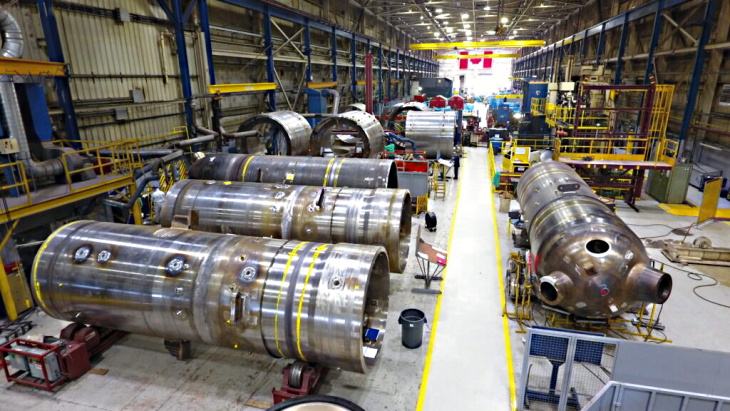Four possibilities for the UK's policy on the recycling of uranium and plutonium stockpiles have been presented in a report by Sir David King, who called for a "holistic approach" to nuclear policy covering legacy materials as well as new build.
The former chief scientific officer in the government of Tony Blair now works at the Smith School of Enterprise and the Environment at the University of Oxford. A report launched today urged the government to make up its mind, because "there is no cheap, do nothing option."
As a pioneer of both nuclear power and nuclear weapons the UK has significant stockpiles of nuclear fuel materials, including some 100 tonnes of plutonium currently viewed as a 'zero value asset'. In addition comes the 6000 tonnes of nuclear fuel used by the Advanced Gas-cooled Reactors since 2007, for which reprocessing is not contracted. Current plans see this being stored until 2075 and then disposed of, although it could be reprocessed to yield over 95% of its mass as reusable fuels. The status of fuel from the Sizewell B pressurized water reactor is the same.
| "Plutonium is a potential weapons material. Convert it to MOX and use it as fuel and you have taken it out of that risk category." |
King's report comes during a government consultation on the situation. It was developed with co-authors Gregg Butler, Grace McGlynn and Michael Evans and contributions from Dame Sue Ion and Owen Owens. King said that Rolls-Royce and Areva had contributed.
Management options
Four options were presented in the report. The first is to simply designate the plutonium and used AGR fuel as wastes and store them while disposal techniques are developed. Plutonium storage was put at £650 million ($1 billion). In the study, it is proposed to incorporate plutonium into mixed-oxide (MOX, uranium and plutonium) pellets because this is the only technique for which a cost estimate could be drawn up (£500 million, $800 million). AGR fuel cannot credibly be kept in current underwater storage until as late as 2075 and it is assumed that a dry storage process can be developed and implemented for something between £100 million and £1 billion ($160 million and $1.6 billion). This scenario has the minimum government expenditure and timescale, but no possibility of revenue to offset this.
Option two is to leave the AGR fuel as waste but mix the plutonium into MOX fuel for use in power reactors. This saves on storage, but requires the additional expense of a new MOX production plant (£2-3 billion, $3.1-4.7 billion). It would also generate revenues to offset the outgoings.
Third was the choice of extending the lifespan of the Thorp facility so that it can reprocess the AGR fuel and use materials from that as well as the plutonium stocks to supply MOX fuel to utilities building new nuclear reactors. This brings additional costs of £1-4 billion ($1.6-6.3 billion) plus £30 million ($48 million) per year for the work at Thorp, while increasing the opportunities for revenue.
The fourth scenario includes the use of a refurbished Thorp to take on more overseas contracts. This is the maximum cost scenario, but also gives the maximum revenues.
During this morning's launch, King and co-author Greg Butler warned that none of the options would be profit-making, but that it could be possible to tackle the issue in a way that reduces overall cost and gives more benefit to the UK economy. The scenarios were analysed under a range of assumptions.
Of the four options, they said, the first choice of designating the materials as waste was practically never the best. Meanwhile, the second option of using plutonium in MOX while disposing of the AGR fuel was always better than the third option that included the reprocessing the AGR fuel.
Only the fourth option - refurbishment of Thorp, reprocessing of the AGR fuel as well as overseas contracts and the use of plutonium in MOX - had the possibility to beat option two, but this would depend on the price available for MOX fuel. Factors for this would be market prices of uranium and enrichment services.
In essence, the report shows that it makes sense to produce MOX fuel from the plutonium. The question for the UK is whether it wants to offset this with extra savings and revenues from the potentially expensive return to the full nuclear fuel cycle that would come with a refurbishment of Thorp.
The report concludes, "There is now an opportunity to develop a holistic approach to nuclear power - combining the assessment of back-end legacy materials with the opportunities offered by new build development."
Ownership of all the materials lies with the UK government, which manages them through the Nuclear Decommissioning Authority. Given a government policy on plutonium, it is this body that must make the decision on how to proceed in the best interests of the UK taxpayer.
The consultation ends on 11 May and the government may make its decision quickly. Using the plutonium in new-build reactors would require some re-working of Generic Design Assessment and other new-build licensing work, as well as strong engagement with utilities.
Researched and written
by World Nuclear News




_69614.jpg)

_15447.jpg)





